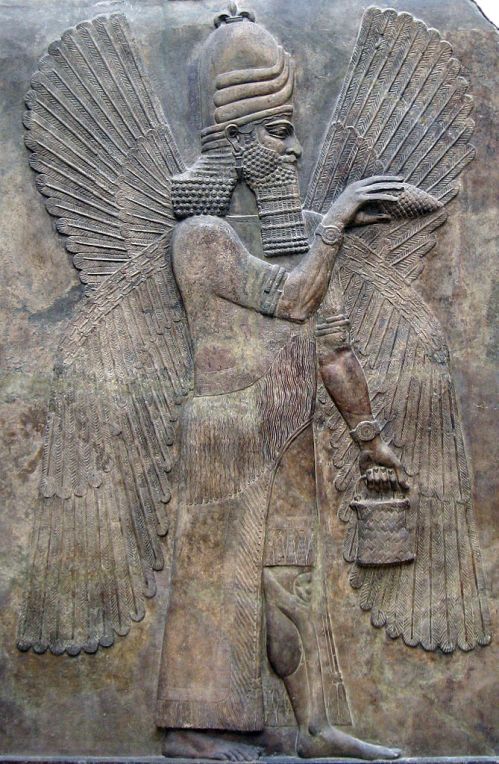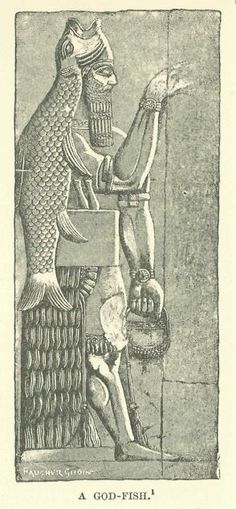Marduk Assimilates All Other Gods
“THE entire religious system of Babylonia is overshadowed, by Merodach, its great patron deity. We remember how he usurped the place of Ea, and in what manner even the legends of that god were made over to him, so that at last he came to be regarded as not only the national god of Babylonia but the creator of the world and of mankind.
He it was who, at the pleading of the other gods, confronted the grisly Tiawath, and having defeated and slain her, formed the earth out of her body and its inhabitants out of his own blood.

Battle between Marduk (Bel) and Tiamat. Drawn from a bas-relief from the Palace of Ashur-nasir-pal, King of Assyria, 885-860 B.C., at Nimrûd.
British Museum, Nimrûd Gallery, Nos. 28 and 29.
http://bharatkalyan97.blogspot.com/2013/06/tablet-of-destinies.html
It is almost certain that this cosmological myth was at one time recounted of Ea, and perhaps even at an earlier date of Bel. The transfer of power from Ea to Merodach, however, was skilfully arranged by the priesthood, for they made Merodach the son of Ea, so that he would naturally inherit his father’s attributes.
In this transfer we observe the passing of the supremacy of the city of Eridu to that of Babylon. Ea, or Oannes, the fish-tailed god of Eridu, stood for the older and more southerly civilization of the Babylonian race, whilst Merodach, patron god of Babylon, a very different type of deity, represented the newer political power.
Originally Merodach appears to have been a sun-god personifying more especially the sun of the springtime. Thus he was a fitting deity to defeat the chaotic Tiawath, who personified darkness and destruction. But there is another side to him—the agricultural side.
Says Jastrow (Religion in Babylonia and Assyria, 1893, p. 38):
“At Nippur, as we shall see, there developed an elaborate lamentation ritual for the occasions when national catastrophes, defeat, failure of crops, destructive storms, and pestilence revealed the displeasure and anger of the gods.”
At such times earnest endeavours were made, through petitions accompanied by fasting and other symbols of contrition, to bring about a reconciliation with the angered power.
This ritual, owing to the religious pre-eminence of Nippur, became the norm and standard throughout the Euphrates Valley, so that when Marduk (Merodach) and Babylonia came practically to replace En-lil and Nippur, the formulas and appeals were transferred to the solar deity of Babylon, who, representing more particularly the sun-god of spring, was well adapted to be viewed as the one to bring blessings and favours after the sorrows and tribulations of the stormy season.
Strange as it will appear, although he was patron god of Babylon he did not originate in that city, but in Eridu, the city of Ea, and probably this is the reason why he was first regarded as the son of Ea. He is also directly associated with Shamash, the chief sun-god of the later pantheon, and is often addressed as the “god of canals” and “opener of subterranean fountains.”
In appearance he is usually drawn with tongues of fire proceeding from his person, thus indicating his solar character. At other times he is represented as standing above the watery deep, with a horned creature at his feet, which also occasionally serves to symbolize Ea.

Large bas-relief of Marduk, Louvre.
https://commons.wikimedia.org/wiki/File:Elam_r_(30).JPG
It is noteworthy, too, that his temple at Babylon bore the same name—E-Sagila, ‘the lofty house,’—as did Ea’s sanctuary at Eridu.
We find among the cuneiform texts—a copy of an older Babylonian text—an interesting little poem which shows how Merodach attracted the attributes of the other gods to himself. .
Ea is the Marduk (or Merodach) of canals;
Ninib is the Marduk of strength;
Nergal is the Marduk of war;
Zamama is the Marduk of battle;
Enlil is the Marduk of sovereignty and control;
Nebo is the Marduk of possession;
Sin is the Marduk of illumination of the night;
Shamash is the Marduk of judgments;
Adad is the Marduk of rain;
Tishpak is the Marduk of the host;
Gal is the Marduk of strength;
Shukamunu is the Marduk of the harvest.
This would seem as if Merodach had absorbed the characteristics of all the other gods of any importance so successfully that he had almost established his position as the sole deity in Babylonia, and that therefore some degree of monotheism had been arrived at.”
Lewis Spence, Myths and Legends of Babylonia and Assyria, 1917, pp. 199-201.

